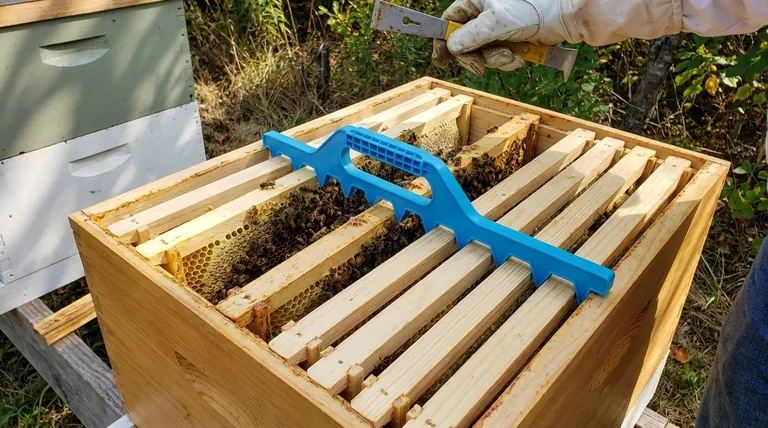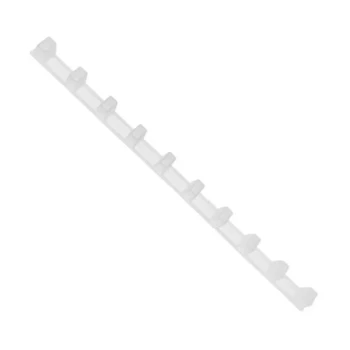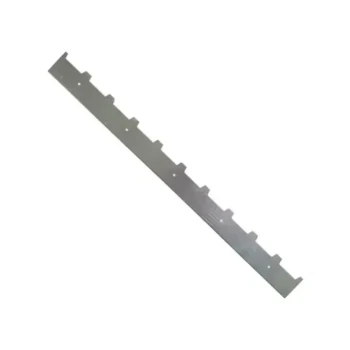By design, a standard 10-frame Langstroth hive box is built to hold exactly 10 frames. This configuration ensures the correct "bee space" is maintained between each frame, which is crucial for the colony's health and organization. However, the technically correct answer doesn't capture the full picture of how beekeepers actually manage their hives.
While a 10-frame box is dimensioned for ten frames, many experienced beekeepers intentionally use only nine, especially in honey supers. This choice represents a fundamental trade-off between maximizing hive capacity and improving the ease of hive management and honey extraction.

The Standard: Using All 10 Frames
The default and most common practice, especially for new beekeepers, is to use all ten frames in a 10-frame box. This method adheres to the principles of hive design established by L.L. Langstroth.
The Importance of "Bee Space"
Langstroth's key discovery was "bee space"—a gap of roughly 1/4 to 3/8 of an inch (6-9 mm). When spacing is within this range, bees leave it as a clear passage. If it's smaller, they seal it with propolis; if it's larger, they build comb in it. Using 10 frames maintains this precise spacing between frames.
Maximizing Brood and Honey Area
Using all 10 frames provides the maximum possible surface area for the queen to lay eggs in the brood box and for bees to store honey and pollen in the honey supers. This configuration is often preferred for establishing a new colony and encouraging rapid population growth.
The Alternative: Using 9 Frames in a 10-Frame Box
Many beekeepers deviate from the standard by intentionally removing one frame and spacing the remaining nine evenly across the 10-frame box. This is sometimes called "9-frame spacing."
The Rationale for Wider Spacing
By spacing 9 frames in a box built for 10, you encourage the bees to draw out the honeycomb on each frame more deeply. The cells are made longer, resulting in "fatter" combs that hold more honey per frame.
The Benefit of Easier Inspections
This is the primary driver for using 9-frame spacing. Tightly packed 10-frame boxes can be difficult to inspect. Frames often get stuck together with propolis and burr comb, and prying them apart can be disruptive, damaging comb and potentially "rolling" (crushing) the queen between frames. Wider spacing makes each frame easier to remove and inspect.
The Advantage for Honey Extraction
Fatter combs are significantly easier to uncap for honey extraction. The beekeeper can run an uncapping knife smoothly across the top of the wooden frame, removing all the wax cappings in one pass. With 10-frame spacing, the drawn comb can sometimes be recessed below the level of the frame, forcing a more tedious uncapping process.
Understanding the Trade-offs
Neither method is universally superior; each comes with distinct advantages and disadvantages that you must weigh based on your goals.
The Challenge of 9-Frame Spacing
The most common issue with 9-frame spacing is the creation of excessive burr comb between hive bodies. Because the combs are fatter, they can reduce the bee space between the top of the lower frames and the bottom of the upper frames, causing the bees to "glue" the boxes together.
The Challenge of 10-Frame Spacing
The primary drawback of using 10 frames is the difficulty of management. Removing the first frame can be very tight, and the risk of harming bees and the queen is higher. Inspections take longer and require more force, which can agitate the colony.
Making the Right Choice for Your Hive
The decision to use 9 or 10 frames often depends on which box you are managing—the brood nest or the honey supers.
- If you are a beginner or managing the brood chamber: Use the standard 10 frames to maintain correct bee space, prevent irregular comb, and support the thermal regulation of the brood nest.
- If your primary focus is efficient honey harvesting: Use 9 frames in your honey supers to get fatter combs that are much easier to uncap and process.
- If you struggle with difficult inspections in your honey supers: Using 9 frames will make removing frames less disruptive and safer for your bees.
Ultimately, understanding how frame count impacts bee behavior empowers you to manage your hive with intention and adapt your equipment to your specific goals.
Summary Table:
| Frame Count | Best For | Key Benefits | Key Drawbacks |
|---|---|---|---|
| 10 Frames | Brood Boxes, Beginners | Maximizes brood/honey area, maintains correct bee space | Frames can be difficult to remove, risk of harming bees |
| 9 Frames | Honey Supers, Easy Harvesting | Easier inspections, fatter combs for simpler uncapping | Can lead to excessive burr comb between boxes |
Ready to optimize your apiary's efficiency?
Whether you manage a commercial operation or distribute beekeeping supplies, the right equipment is key to productivity and bee health. HONESTBEE supplies durable, precision-engineered hive components and beekeeping equipment to commercial apiaries and distributors through our wholesale-focused operations.
Let us help you equip your hives for success. Contact our team today to discuss your specific needs and explore our product catalog.
Visual Guide

Related Products
- Ergonomic Plastic Frame Spacer Tool for Rapid Hive Management Beekeeping
- Durable Plastic Frame Spacer
- Stainless Steel 9 Frame Hive Spacer Durable Precise for Commercial Beekeeping
- Langstroth Bee Hives Bee Keeping Box for Beginners Beekeeping
- HONESTBEE Professional Long Handled Hive Tool with Precision Cutting Blade
People Also Ask
- Why is it important to maintain accurate measurements in a Langstroth hive? Ensure Hive Health and Manageability
- Why are my bees building combs between frames? Fix Cross Comb for Better Hive Management
- What is 'bee space' and why is it important? The Key to Modern Beekeeping Success
- What to do if bees are building combs between frames? A Guide to Fixing Burr Comb
- What is 'Bee Space' or 'Bee Passage' and why is it important in beekeeping? The Key to Modern Hive Management



















